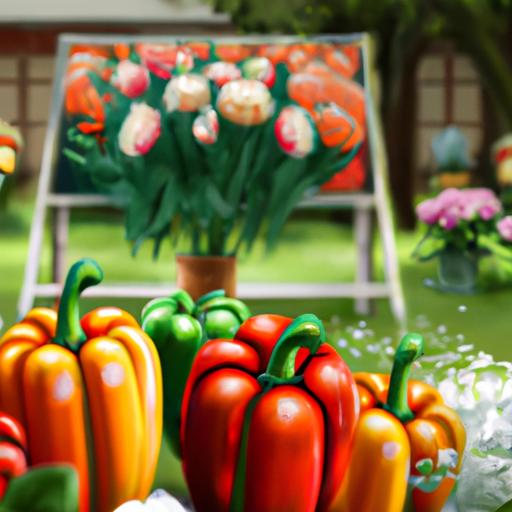Do you love the taste of freshly harvested bell peppers, but you’re not sure when is the best time to pick them? If so, you’re in luck! In this article, we’ll reveal the secrets to ensuring a bumper crop of bell peppers and the optimal time to pick them.
Read on to learn all the tips and tricks for getting the most out of your bell pepper harvest!
Table of Contents
When To Pick Bell Peppers?
When it comes to harvesting bell peppers, timing is key.
For the best quality, pick them when they are at their peak ripeness.
To determine if a bell pepper is ripe and ready to be picked, check the color – if it’s bright green, it’s not yet ripe, but if it’s a deep green, red, yellow, or orange, it’s ready to go.
Additionally, give it a gentle squeeze – it should feel slightly firm; if it’s soft or mushy, it’s too ripe and should not be picked.
Lastly, look at the size – if it’s full-sized, it’s ready to be harvested.
In summary, ripe and ready bell peppers should be a deep green, red, yellow, or orange color; have a slightly firm texture; and be full-sized.
If they meet these criteria, they are ripe and ready to be picked.
How Do You Know When Bell Peppers Are Ready?

When it comes to knowing when bell peppers are ripe, there are several indicators to look for.
Firstly, the color of the pepper will typically start out light green and then turn into a variety of colors such as red, yellow, orange, and purple when the desired hue is reached.
Secondly, bell peppers will usually grow in size, ranging from small to large, when they are ready to be harvested.
Additionally, the texture of the pepper should be firm and not too soft or too hard when pressed.
Lastly, a taste test can also be done to ensure that the pepper is sweet, flavorful, and crunchy.
In summary, bell peppers are usually ready for harvesting when they have the desired color, size, and texture.
To double-check, you can do a taste test.
Can You Pick A Bell Pepper Too Early?
Yes, you can pick a bell pepper too early.
Just like any other fruit or vegetable, bell peppers should be harvested when they are ripe for the best flavor and texture.
If you pick a bell pepper before it reaches full ripeness, it will be underdeveloped and may have a bitter taste.
Its skin will also be harder and more difficult to cut, making it harder to use in recipes.
The best time to harvest bell peppers is when they have reached their full size and have turned the desired color.
This can vary depending on the variety, but usually when the pepper is bright green, yellow, orange, or red.
If you pick a bell pepper before it is ripe, it will not ripen any further once it is harvested.
When harvesting bell peppers, use sharp shears or scissors to avoid damaging the plant.
Be careful not to pull or tug on the pepper as this can cause the plant to break.
The peppers should be handled gently and carefully.
Also consider the time of year when harvesting bell peppers.
In most climates, peppers will be ready for harvest in late spring or early summer.
If you pick bell peppers too early in the season, they may not reach full maturity and will have an inferior taste.
Picking bell peppers too early can negatively affect their quality and flavor.
Be patient and wait until the pepper has reached its peak ripeness before harvesting.
Doing so will ensure the best flavor and texture of the peppers.
How Big Should A Bell Pepper Be When You Pick It?
When selecting bell peppers, size is an important factor to consider.
Choose a pepper based on the desired usage smaller peppers tend to be more tender and sweeter in flavor, while larger peppers are better for stuffing.
Look for bell peppers that are firm, with a glossy texture and vibrant color.
Avoid peppers that are discolored or have soft spots.
In general, bell peppers should be at least 3 inches in diameter, but it’s best to select peppers that are the size you need for a particular recipe.
Smaller peppers are ideal for a crunchy texture and a mild flavor, while larger peppers provide a firmer texture.
Choose the size that best fits your needs sweeter flavor or firmer texture and you’ll be sure to find the perfect pepper.
How Long Does It Take For Green Peppers To Turn Red?

On average, it takes between three and four months for a green pepper to turn red.
However, the exact time it takes for the pepper to ripen into a red color can vary, depending on the variety, growing conditions, and the time of year it was planted.
Green peppers are actually immature bell peppers, transitioning from green to yellow, orange, and finally red.
The ripening process is influenced by the amount of sunlight and the temperature of the environment, with warmer climates typically speeding up the process.
You can also speed up the ripening process by harvesting the pepper when it is still green, either by picking it or cutting it off the vine.
If you want to ensure that your peppers will turn red, look for varieties specifically bred for this purpose.
These types of peppers will usually turn red earlier than other varieties and are often labeled accordingly.
In summary, you can expect green peppers to turn red within three to four months on average.
However, this time period can be accelerated or delayed depending on the variety, climate, and other factors.
Should I Pick My Peppers Before They Turn Red?
When it comes to harvesting peppers, whether you should pick them before or after they turn red depends on your plans for them.
If you want to eat them raw, picking them before they become red will give you a milder and sweeter pepper.
On the other hand, if you are looking to cook them, allowing them to turn red will give you a pepper that is more flavorful and full-bodied.
Additionally, if you need peppers for a specific purpose, such as making a hot sauce or salsa, picking them before they turn red will give you a less spicy pepper, which is ideal if you don’t want too much heat.
But if you want a pepper with a bit of kick, you should wait until they turn red.
Finally, take into account the time it takes for each variety of pepper to turn red.
Some peppers, like bell peppers, can take weeks to turn red, while others may only take a few days.
Knowing how long it takes for the peppers to turn red is important if you want to harvest them after a certain amount of time.
In the end, it depends on what you want to do with your peppers and how much time you have.
If you want a milder, sweeter pepper, pick them before they turn red.
If you want a rich, flavorful pepper, wait until they turn red.
Whichever option you choose, make sure to pick them at the right time for the best results.
Do Bell Peppers Last Longer Cut Or Uncut?
When it comes to bell peppers, the answer to the question of whether they last longer cut or uncut depends on the environment and how soon you plan to consume them.
If you plan to eat them within a few days, it’s best to keep them uncut.
This is because bell peppers will stay freshest when stored in a cool, dry place, such as the refrigerator.
Uncut peppers are less likely to spoil than cut ones since they are exposed to less air and are less likely to dry out.
However, if you want to consume the bell peppers a few days later, it’s best to cut them.
Cutting them will release ethylene gas, which slows down the ripening process.
Therefore, by cutting them and storing them in the refrigerator, they will last longer than if they were left uncut.
To sum up, the answer to whether bell peppers last longer cut or uncut depends on the environment and how soon you plan to consume them.
If you plan to eat them soon, then leave them uncut.
If you plan to eat them a few days later, then cut them and store them in the refrigerator.
How Long Do You Leave Bell Peppers On The Plant?

How long you should leave bell peppers on the plant depends on the variety and desired ripeness.
Generally, peppers will be ready for harvesting between 45 to 120 days after planting.
You can tell when the peppers are ripe by their color from green to red, yellow, orange, or even purple.
For preserving, it is best to leave them on the plant until fully mature for a sweeter flavor and higher nutritional content.
However, it is important to monitor the peppers to avoid over-ripening, which can cause them to rot, become diseased, or be attacked by pests.
How Long Does It Take Bell Peppers To Ripen On The Vine?
When it comes to ripening bell peppers, the answer depends on a few factors.
First, the variety you select is key, as different varieties have different ripening times.
In general, it can take anywhere from 45 to 100 days for peppers to ripen on the vine.
This estimate can be affected by the weather and climate hot and sunny days can accelerate the ripening process, while cooler temperatures can slow it down.
Additionally, you can also speed up the ripening process by picking peppers when they are still a bit green or by pinching off the flowers to direct the plant’s energy to the fruits that are already developing.
Remember, bell peppers can still be eaten even if they don’t reach full maturity in fact, peppers are often picked when they are still green and immature, as they can still be quite flavorful.
To ensure that your peppers ripen within a reasonable timeframe, it’s important to do your research and pick a variety that fits your needs, as well as to pay attention to the weather.
Do All Green Bell Peppers Turn Red When Ripe?
No, not all green bell peppers turn red when ripe.
While it is true that some varieties, such as the California Wonder, will turn red when left to ripen, others may turn yellow, orange, or even purple.
Bell peppers are typically harvested when unripe and green for the firmest, most flavorful texture.
If left on the vine to ripen, the color will vary depending on the variety – the Yolo Wonder will turn yellow, while the Purple Bell will turn purple.
Some bell peppers, such as the Cubanelle variety, will stay green even when ripe.
To tell if this type of pepper is ripe, look at the texture of the skin – if it softens, it is usually ripe.
In conclusion, the color of bell peppers when ripe varies depending on the variety and some may not change color at all.
Final Thoughts
Now that you know the secrets to a bumper crop of bell peppers, it’s time to put your newfound knowledge to work.
Get out there and plan your bell pepper harvest according to the tips we’ve shared.
With a bit of patience and the right timing, you’ll be able to enjoy the perfect bell pepper harvest!

